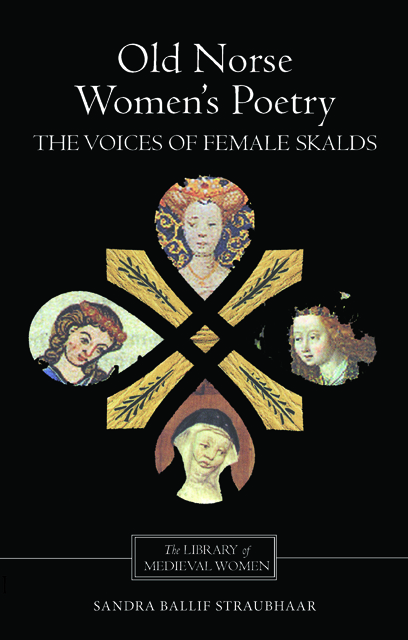Book contents
- Frontmatter
- Contents
- Foreword
- Abbreviations
- Introduction
- I. Real People, Real Poetry
- II. Quasi-Historical People and Poetry
- III. Visionary Women: Women’s Dream-Verse
- IV. Legendary Heroines
- V. Magic-Workers, Prophetesses, and Alien Maidens
- VI. Trollwomen
- Old Norse Literature Time Line
- Glossary of Personal Names
- Bibliography
- Index of Names
- Library of Medieval Women
II. - Quasi-Historical People and Poetry
Published online by Cambridge University Press: 14 February 2023
- Frontmatter
- Contents
- Foreword
- Abbreviations
- Introduction
- I. Real People, Real Poetry
- II. Quasi-Historical People and Poetry
- III. Visionary Women: Women’s Dream-Verse
- IV. Legendary Heroines
- V. Magic-Workers, Prophetesses, and Alien Maidens
- VI. Trollwomen
- Old Norse Literature Time Line
- Glossary of Personal Names
- Bibliography
- Index of Names
- Library of Medieval Women
Summary
This second section contains material generically similar to that in the first section, largely culled from the more or less realistic narratives of the Icelandic family sagas. The following fragments, however, are less likely than those in Section I to be what they claim to be. Textual anachronisms, or tell-tale elements in the poems’ prose environments, make it less likely that these compositions can be attributed to historically attestable persons. The poems appear roughly in order of historical likelihood (most likely first).
Fóstra Þórodds Þorbrandssonar (Þóroddr Þorbrandsson’s Foster-Mother)
Ostensibly early eleventh century, Iceland
Eyrbyggja saga, ch. 63 (ed. Einar Ólafur Sveinsson and Matthías Þórðarson) FJ IB, 394–5; Kock I, 195
SPSMA (ed. Judy Quinn):
http://skaldic.arts.usyd.edu.au/db.php?table=verses&id=1340
Þóroddr’s foster-mother warns him about Glæsir, the ghost bull
Eyrbyggja saga is known for its numerous hauntings, of which the bull Glæsir (Shiny, Glossy) is only one example. He is said to have been conceived when a cow licked up the funerary ashes of a bothersome human ghost.
Like Gunnhildr konungamóðir (Section I) and many of the prophetesses (spákonur) of Section V, Þóroddr’s foster-mother finds herself in the unenviable position of telling a stubborn man a true prophecy that he does not want to hear. In this case the urgency of the speaker comes through with particular force, in these two intense dróttkvætt stanzas.
The herd-leader shakes his head with a blood-boding voice; he will kill people. The shaker-of-the-hair-of-snow [old woman] totters. He will teach you to go to a turf-cut wound in the earth [a grave]. It will happen that the animal will deprive you of your life, and I see it clearly.
Arnfinnsdóttir jarls
Ostensibly tenth century, Halland (Denmark then, Sweden today)
Egils saga Skalla-Grímssonar, ch. 48 (ed. Sigurður Nordal)
FJ IB, 604; Kock I, 294
SPSMA (ed. Margaret Clunies Ross):
http://skaldic.arts.usyd.edu.au/db.php?table=verses&id=1424
Jarl Arnfiðr’s daughter mocks Egill’s prowess
This imperfect dróttkvætt stanza and its surrounding episode seem to have no other purpose, in a saga otherwise studded with poetry, than to goad the youthful saga-hero, Egill Skalla-Grímsson, to further deeds. Its authenticity is thus suspect, but the scene is no less memorable.
- Type
- Chapter
- Information
- Old Norse Women's PoetryThe Voices of Female Skalds, pp. 23 - 38Publisher: Boydell & BrewerPrint publication year: 2011

